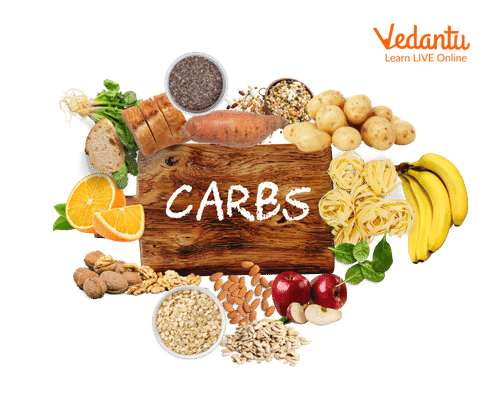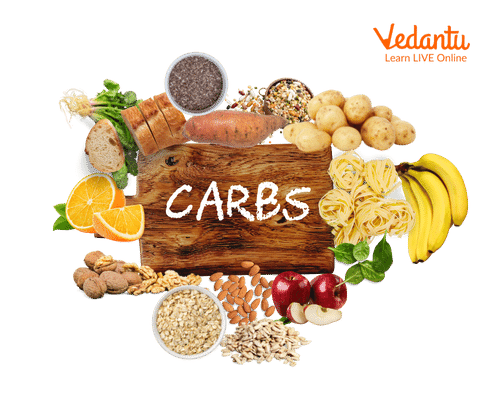Simple Guide: How Carbohydrates Support Student Health and Energy
The concept of sources of carbohydrates is essential in biology and helps explain real-world biological processes and exam-level questions effectively.
Understanding Sources of Carbohydrates
Sources of carbohydrates refer to various foods that supply carbohydrates, an essential nutrient, in our diet. This concept is important in areas like nutrition, balanced diet, metabolism, and energy production. Carbohydrates are the body's main source of energy and are abundant in many plant and animal foods. Recognising and differentiating these sources helps you create healthier meal plans and answer competitive exam questions confidently.

Functions of Carbohydrates in the Body
Carbohydrates play several key roles in our body:
- They are the primary source of energy for daily activities.
- Help in proper functioning of organs, especially the brain and muscles.
- Support digestive health through fibre (a type of carbohydrate).
- Prevent protein from being used for energy so proteins can build and repair body tissues instead.
- Assist in maintaining healthy blood sugar levels.
Main Sources of Carbohydrates in Food
Sources of carbohydrates are found in almost every type of food, especially plant-based foods. Below is a list covering major and common examples:
- Cereals and Grains: Rice, wheat, maize, oats, barley, and products made from these grains like bread and pasta.
- Starchy Vegetables: Potatoes, sweet potatoes, corn, yam, pumpkin.
- Legumes and Pulses: Beans, lentils, peas, chickpeas, soybeans.
- Fruits: Bananas, apples, mangoes, pineapples, berries, oranges.
- Milk and Dairy Products: Milk, yogurt, cheese (contain lactose, a natural sugar).
- Sugary Foods (unhealthy sources): Soft drinks, white bread, pastries, candies, processed snacks.
For healthier choices, prefer whole grains, fresh fruits, and vegetables instead of refined and sugary foods.
Table: Common Sources of Carbohydrates
| Food Group | Examples | Type of Carbohydrate |
|---|---|---|
| Cereals & Grains | Rice, Wheat, Oats, Barley, Bread, Pasta | Starch |
| Starchy Vegetables | Potato, Sweet Potato, Corn, Pumpkin | Starch, Fibre |
| Fruits | Banana, Mango, Apple, Orange, Berries | Sugars (Glucose, Fructose), Fibre |
| Legumes & Pulses | Beans, Lentils, Peas, Chickpeas, Soybeans | Starch, Fibre |
| Milk & Dairy | Milk, Yogurt | Lactose (Sugar) |
Visual Aids: Carbohydrate-Rich Foods

These visual examples make it easier for you to identify common carbohydrate sources for your exams and daily diet planning.
Comparison: Carbohydrates vs Fats and Proteins as Food Sources
| Nutrient | Primary Food Sources | Main Role |
|---|---|---|
| Carbohydrates | Cereals, Fruits, Potatoes, Milk | Quick energy |
| Fats | Oils, Butter, Nuts, Seeds, Ghee | Stored energy, insulation |
| Proteins | Pulses, Eggs, Fish, Meat, Dairy | Growth, repair |
Quick Revision: Key Points on Sources of Carbohydrates
- Carbohydrates are mainly found in cereals, fruits, starchy vegetables, legumes, and dairy.
- Whole grains, fruits, and vegetables are considered healthy sources.
- Starch, sugars, and fibre are different forms of dietary carbohydrates.
- Unhealthy (refined) foods can provide carbohydrates but lack fibre and nutrients.
- For exams, remember examples like rice, bread, potato, banana, beans, and milk.
Practice Questions
- List five healthy sources of carbohydrates with examples.
- How do carbohydrates differ from proteins and fats in food sources?
- Why should we choose whole grains over refined grains for carbohydrate intake?
- Draw and label a table comparing dietary sources of all three macronutrients.
Common Mistakes to Avoid
- Confusing sources of carbohydrates with sources of fats and proteins.
- Assuming all sugary foods are healthy carbohydrate sources.
- Ignoring the importance of dietary fibre found in some carbohydrate foods.
Real-World Applications
The concept of sources of carbohydrates is used in fields like medicine, agriculture, biotechnology, and environmental science. Choosing the right carbohydrate sources supports healthy growth, athletic performance, and disease prevention. Vedantu helps students relate such topics to practical examples in daily life and academic exams.
In this article, we explored sources of carbohydrates, their main types, real-life significance, and how to identify food groups rich in carbohydrates. To learn more and build confidence, keep practicing with Vedantu and explore related topics like components of food, function of carbohydrates, and balanced diet for a deeper understanding.


FAQs on Major Sources of Carbohydrates: Key Foods & Examples
1. What are sources of carbohydrates?
Sources of carbohydrates include a wide variety of foods such as cereals (rice, wheat, maize), fruits (bananas, apples, mangoes), vegetables (potatoes, carrots), legumes (beans, lentils), and dairy products (milk, yogurt). These foods provide energy through their carbohydrate content, primarily in the form of sugars, starches, and dietary fiber.
2. Can you list 10 sources of carbohydrates?
Some common carbohydrate-rich foods are: 1) Rice, 2) Wheat, 3) Maize, 4) Potatoes, 5) Bananas, 6) Bread, 7) Beans, 8) Lentils, 9) Milk, and 10) Fruits like apples and mangoes. These sources provide both simple and complex carbohydrates essential for energy and nutrition.
3. What are the three main sources of carbohydrates?
The three main sources of carbohydrates are: grains (such as rice and wheat), fruits and vegetables (like bananas and potatoes), and dairy products (such as milk and yogurt). These groups contain different types of carbohydrates including starch, sugars, and fiber.
4. What is the function of carbohydrates in our body?
The primary function of carbohydrates is to provide a quick and efficient source of energy for the body's cells. They also help in: maintaining healthy digestive system through dietary fiber, preventing the body from using protein as an energy source, and supporting the structure of connective tissues. Fiber from carbohydrates additionally aids in lowering blood cholesterol.
5. What are carbohydrates examples?
Examples of carbohydrates include simple carbohydrates like glucose, fructose (found in fruits), and lactose (in milk), as well as complex carbohydrates such as starches found in rice, potatoes, beans, and whole grains. Fibrous carbohydrates found in vegetables like carrots and broccoli also contribute to dietary fiber intake.
6. Which food items are rich in carbohydrates?
Food items rich in carbohydrates include cereals (rice, wheat, maize), tubers (potatoes, sweet potatoes), legumes (beans, lentils), fruits (bananas, mangoes), vegetables (carrots, pumpkins), and dairy products (milk, yogurt). These foods provide essential glucose for energy and other metabolic functions.
7. Why do students often confuse carbohydrate sources with protein or fat sources?
Students often confuse carbohydrate sources with protein or fat sources because some foods contain a mix of macronutrients. For example, legumes contain both carbohydrates and proteins, while dairy products contain both fats and carbohydrates. Understanding the primary macronutrient in each food and its energy contribution helps reduce confusion.
8. Are all starchy foods high in carbohydrates?
Yes, most starchy foods are high in carbohydrates because starch is a complex carbohydrate. Foods like potatoes, rice, corn, and wheat contain large amounts of starch, making them rich energy sources. However, the nutritional quality varies based on refinement and processing.
9. How does cooking affect carbohydrate content?
Cooking generally does not reduce the total amount of carbohydrates in food but can affect their digestibility. For example, cooking breaks down starch granules, making carbohydrates easier to digest and absorb. Some cooking methods may reduce fiber content slightly, but the energy-providing carbohydrates remain.
10. Why is fibre, despite being a carbohydrate, not considered a quick energy source?
Although fibre is a type of carbohydrate, it is not digested into glucose and therefore does not provide quick energy. Instead, fiber aids in digestive health by promoting bowel movements and lowering blood cholesterol levels. It also helps regulate blood sugar by slowing carbohydrate absorption.
11. Why is milk listed as a carbohydrate source but eggs are not?
Milk contains lactose, which is a natural sugar and a form of carbohydrate, making milk a source of carbohydrates. Eggs, on the other hand, have negligible carbohydrate content and are primarily sources of proteins and fats. This difference explains why milk is considered a carbohydrate source while eggs are not.










